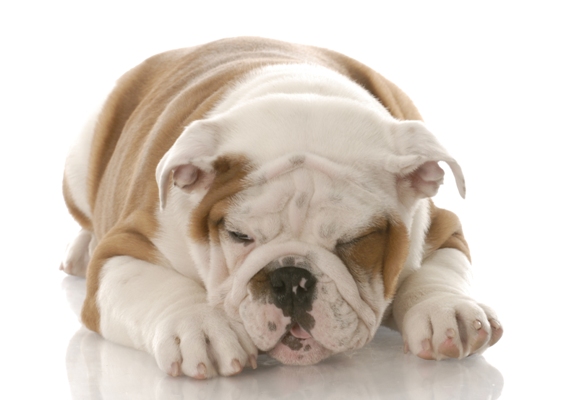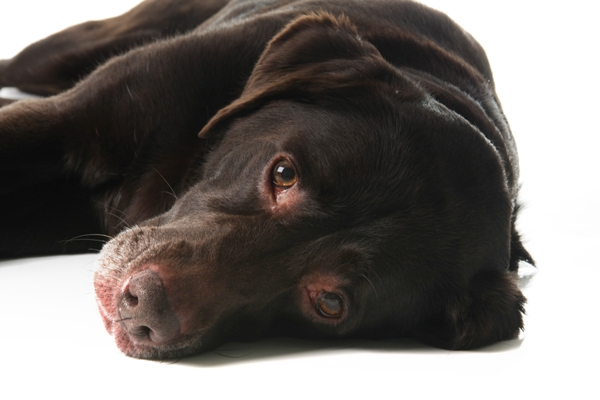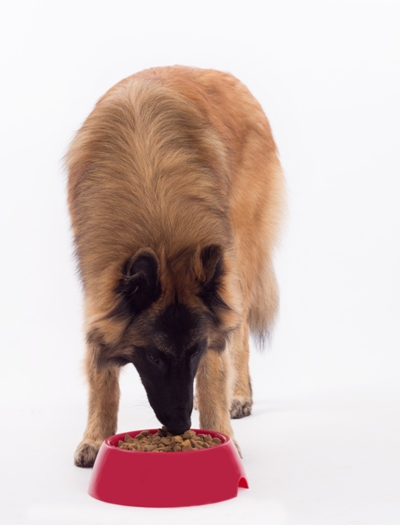Dog Bloat Symptoms and Treatments
Dog Bloat, ‘Bloat’, ‘Twisted Stomach’ or Gastric Dilatation-Volvulus (GDV), as it’s formally known, is a life-threatening condition that causes the stomach will with gases and rotate on itself, cutting off blood circulation.
There are two distinct parts to the condition. First, the gastric dilation or ‘bloat’ is when the stomach fills with air and puts huge pressure on the surrounding organs. The second phase, volvulus or ‘torsion’ occurs when the bloated stomach compresses large veins and begins to rotate, cutting off the blood supply. From this point the stomach will begin to die and the dog’s health will rapidly deteriorate, resulting in death.
While dog bloat or GDV is extremely dangerous to dogs, the causes for gastric dilation-volvulus are largely unknown. It is thought that a variety of factors are to blame; these include genetic, anatomical and environmental causes. Dogs that have been born to a mother with a history of bloat will, generally speaking, be more likely to develop the condition. Dog bloat is also more common in older dogs, although GDV has been known to sometimes occur in puppies.
It’s thought that gastric dilation-volvulus will be more likely to occur if the dog ingests excessive amounts of food or water in one sitting. It is also believed that GDV can be caused by rigorous exercise too soon after feeding time.
Dog bloat is a serious condition, known to be one of the biggest threats to a dog’s health, second to cancer. Deep-chested breeds tend to be the most commonly affected with Great Danes, German Shepherds and Dobermans particularly at risk.
The condition can cause serious injury to the stomach and other essential organs soon after symptoms begin to show. Death can occur in a matter of hours, sometimes even minutes after GDV progresses. Therefore, if signs of gastric dilation-volvulus develop, immediate medical care is required.
SYMPTOMS
Dog bloat will cause a great deal of discomfort for your dog and if the condition is developing, a clear list of symptoms will shortly develop. Although symptoms may not show in the early stages of gastric dilation-volvulus, your dog will become progressively distressed as the condition progresses.
Some important signs that may point to GDV include:
- Severe Restlessness. Your dog may not be able to sit and rest as it usually does, especially after exercise and feeding time. Keep an eye out for any signs of uncharacteristic nervousness or stress.
- Directionless Pacing. If your dog is pacing about for no apparent reason, paired with the inability to sit down, lie down and rest, this could be a sign of bloat.
- Constant Retching. Dogs will vomit for a number of reasons and not all of these will point to illness. If your dog is retching violently without vomiting, then GDV could be the cause. In the case your dog is producing vomit then the chance of bloat is unlikely. Increased salivation can also be a sign of bloat.
- Your dog will show signs of anxiety or distress if suffering from bloat. Whining, whimpering or groaning while touching the abdomen could mean that GDV is the cause.
- Gastric dilation-volvulus will affect your dog’s enthusiasm for exercise. If you notice that your dog is looking downtrodden whilst pacing, coupled with stiffness in the legs, then the animal is clearly uncomfortable.
While some of these symptoms are not specifically unique to gastric dilation-volvulus, dog’s showing any or a combination of these symptoms should be taken to the vet for observation.

DIAGNOSIS
In order to diagnose dog bloat a number of factors are taken into consideration. Your vet will take into account your dog’s breed and will most likely ask you about the dog’s history and living environment. Breeds that are larger with deep chests are far more likely to develop gastric dilation-volvulus and the likelihood is increased with age.
Your vet will conduct a physical exam of the animal. If GDV has in fact occurred, tell-tale signs will include an enlarged abdomen, tenderness around the affected area and excessive salivation, sometimes with frothing from the mouth. Increased heart rate, the presence of pale mucous membranes and poor pulse quality points to the onset of shock and suggests the latter stages of bloat.
A number of tests will be taken including x-rays and a urine sample. X-rays will show that the stomach is filled with gas and will also show any signs of twisting. If the pylorus (the opening that joins the stomach and intestines) is displaced, it is a sure sign of GDV. The condition is considered a medical emergency and, if bloat is diagnosed, then your veterinarian will act immediately.
TREATMENT AND MANAGEMENT
When diagnosed with gastric dilation-volvulus, your dog will require immediate action to avoid serious damage to the stomach and surrounding organs. GDV is a life-threatening condition and will cause the animal quite a deal of stress. Stabilisation is required first; this will usually include the administering of IV fluids and oxygen therapy.
The aim of the veterinarian is to release the build-up of gases in the dog’s stomach. This will usually involve the insertion of a tube down the oesophagus and into the stomach. Water may also be flushed in and out of the stomach to clean out any remaining food particles. In other cases a needle may be inserted from the outside of the body and directly into the stomach to release the gases. In either case, a general anaesthetic is usually used.
To untwist the stomach, surgery is required. The health of the surrounding organs will also be assessed at this time. Once the stomach has be rotated back into position and the build-up of gas removed, the stomach is then permanently attached to the abdominal wall. This procedure is ensure that, if bloat occurs again, the stomach will not rotate.
After one or both of these procedures, your vet will likely keep your dog in hospital for a number of days for close observation. The heart, as well as eating habits and general health will all be monitored.

PREVENTION
Although the exact causes of GDV are not known, there are a number of things that can help to prevent its onset. Larger breeds with deep chests will be much more likely to develop the condition than smaller dogs and these suggestions can help keep it at bay.
Many vets suggest that large meals are the cause of GDV, followed immediately by rigorous exercise. If you have one of the most affected breeds, try feeding your dog smaller meals, more often to break up the amount of food ingested at one time.
Always avoid exercise immediately after meal time. Just like humans, dogs need time to digest their food. Give your dog at least an hour or more to settle their stomachs after eating, followed by a level of exercise that builds slowly.
It’s also suggested that large amounts of water should be held back during feeding time. If your dog is one of the high-risk breeds, be sure to have them on an appropriate diet; this means no grains or any other fermentable carbohydrates.
The rate of ingestion is thought to have an effect on dog bloat. Dogs that cohabitate with other animals will tend to eat much faster for fear of competition. If you have more than one dog at home, try feeding the animals in separate locations.
COMMONLY AFFECTED BREEDS
Any large, deep-chested dog is susceptible to developing gastric dilation-volvulus or ‘dog bloat’. The breeds most likely to develop the condition include: the Great Dane, Basset Hound, Old English Sheepdog, German Pointer, Doberman, Newfoundland, German Shepherd, Saint Bernard, Weimaraner, Poodle and Irish Setter.

INTERESTING DOG BLOAT FACTS
A recent study in the US found that 50% of dogs using elevated food dishes developed GDV. This suggests that the height of a dog’s bowl from the ground may play a role.
Dry foods will have a great deal of carbohydrates that will produce gases in the dog’s stomach during digestion. There is not usually any problems with feeding your dog dry food; GDV can develop if the gasses aren’t expelled.
It’s believed that there is a link between the pace at which a dog eats, the amount of food and water it ingests during each sitting and how soon after feeding the dog is exercised. To avoid the onset of bloat, slower eating, smaller meals and exercising the animal long after feeding are all considered great preventatives.
FOR MORE INFORMATION
https://www.acvs.org/small-animal/gastric-dilatation-volvulus
